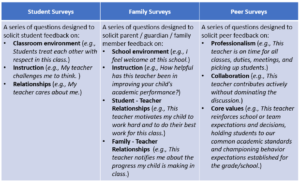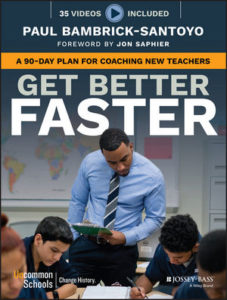Posts Tagged ‘New Teachers’
Make Your Pick: How the NFL Draft Applies to Teacher Hiring
While there is a lot of best practice research out there about how to hire a great team, leaders seeking teacher talent can take a cue from how professional sports teams scope out and draft players. In the post below, we bring Cade Massey’s article on 5 lessons we can learn from the NFL draft into the world of teacher hiring.
1. Know what you need. Before you even begin to recruit teachers, be clear on what type of teacher you need for your school. Of course, certification, grade and subject-area matches matter, but identifying a great fit requires more. Assess your current staff to identify where your team has strengths, and where there are gaps. Perhaps you need a teacher with great data skills who can support your team’s efforts to review and act on student outcomes. Or perhaps you need a teacher who can effectively implement writing across the curriculum. Also consider your strengths as a leader; do you have capacity to coach a novice teacher? Or do you need someone with more experience? Being clear about the ideal profile of a candidate can help ensure that you focus your limited resources on a hiring process that will yield the best outcome.
2. Get input from others. While the school leader is often the driver and decision-maker when it comes to hiring, ensuring that teachers, other leaders, and even parents are engaged in selection will help ensure that the best candidate is chosen for the school. Consider a process that allows you to solicit input and ideas from a variety of stakeholders. Allow each stakeholder to have an independent review of finalists, and to form their own perspective about fit. One easy way to engage multiple stakeholders quickly is to use a panel interview, or to have multiple stakeholders act as students in a demo lesson (see item 3).
3. Understand the candidate from multiple angles. Resume reviews and interviews are a great first step in getting to know a teacher candidate. But, often that isn’t enough. As football scouts actually see candidates play, getting a glimpse of your top candidates teaching will help you understand how they may fit into your school culture. Request a video of the candidate teaching, or request that they teach a demo lesson in your school or with your selection committee. Even observing 10 minutes of teaching can help you get a full picture of the candidate’s skills and growth areas.
4. Be consistent in your selection model. Hiring is about assessing people, which can be a messy business. No matter how disciplined we are, our opinions of others are naturally informed by the biases we carry; we’re all human after all. As you design your selection approach, consider a rubric and scoring mechanism that makes considering multiple variables factors more formulaic. Bringing order and data to a process like hiring can help ensure that factors like selection bias do not play a significant role in who is selected for your school.
5. Keep score and reevaluate. The only way to know if your selection process worked is to map it against results. Once you’ve selected your dream candidate(s), keep a record of the selection process and the factors that led to their hire. Then, after their first year, compare the teacher’s results to your selection. How accurate was your assessment of their strengths and growth areas? Did your selection approach yield a candidate that made gains with students? If so, what should you replicate? If not, what might you tweak for future hiring?
Sound off in the comments: What lessons have you learned from teacher hiring? What strategies have been most useful in identifying your best candidates?
Designing Evaluation Frameworks with Development at the Core – Part III: Amplifying Stakeholder Voice with Surveys
This post is the third in a series on how innovators are reimagining the design and implementation of evaluation and development frameworks. Read our earlier posts on observation frequency and raising rubric rigor.
When you think of a teacher, where are they? What are they doing? If you envisioned someone standing in front of a blackboard, lecturing a group of students, you’re likely not alone. In reality however, teachers spend their days in a multitude of ways: working individually with students, collaborating with peers, planning independently, connecting with parents and family members.
Definitions of excellent teaching therefore must go beyond classroom observations and measures of student outcomes (both of which are important!), to gather a broader view of a teacher’s impact.
Surveys are a simple, yet powerful tool that can amplify the voices of stakeholders from across a school community to help educators develop a comprehensive view of excellence.
The Benefits of Administering Surveys
- Surveys, coupled with other measures like classroom observations, provide rich information to help teachers improve their practice. Teaching is a complex job that depends on strong relationships. While districts and schools have made progress in collecting data and providing feedback on certain aspects of the profession (e.g., content knowledge, teaching strategies, assessment data), our field often misses the opportunity to coach teachers on their relationship building with students, families and peers.
- Research says that students are reliable evaluators of a teacher’s impact. Analysis by the Measures of Effective Teaching (MET) project finds that teachers’ student survey results are predictive of student achievement gains. In other words, students know an effective classroom when they experience one.
- Surveys provide the opportunity to put values into practice. Value statements like “we are a team and family” or “parents are partners” are powerful; however, these beliefs are only as true as the actions taken to build an authentic community. Administering surveys of key stakeholders sends a strong message that the voices of community members are valued, respected and heard.
- Surveys provide clear and transparent expectations to teachers. When questions are shared with teachers in advance, the survey content provides clear definitions for expected behaviors in teacher-to-teacher, teacher-to-student, and teacher-to-family relationships. For example, if a survey asks families if they receive one or more positive phone calls a month from their child’s teacher, that sets a very clear expectations for the teacher-family relationship.
Survey Types
Educators have available a number of survey types, structures, question formats and administration platforms.The table below highlights three common survey types.
Surveys should be designed thoughtfully, taking into consideration the purpose, audience, and respondents.
- Purpose – Why are you administering the survey? What do you hope to learn? How will results be utilized?
- Audience – Who will analyze and interpret the survey results? When and how will they reflect on and plan from the results? How will the results be debriefed with teachers to improve practice?
- Respondents – Who will complete the survey? When and how will they complete the survey? What directions, supports and technology will be necessary for administration?

To learn more, including a list of sample survey questions, visit the resources page of our website.
5 Strategies for Scaling Effective Coaching
Our team spends a lot of time thinking about how to develop teachers. We believe that investing in the professional growth of teachers has the potential to dramatically change the landscape of education in our country and the lives of millions of children. While school systems across the U.S. spend billions of dollars annually on teacher professional learning and development we have little proof of their efficacy (The Mirage, TNTP 2015).
Given this context, we were thrilled to read a new study, The Effect of Teacher Coaching on Instruction and Achievement by Matthew Kraft and Dylan Hogan of Brown University and David Blazar from Harvard University. Kraft and his team conducted a meta-analysis of 37 studies and found coaching programs to positively impact instruction (.57 standard deviations) and student achievement (.11 standard deviations). The authors offer the following summary:
The results of our meta-analysis suggest that teacher coaching programs hold real promise for improving teachers’ instructional practice and, in turn, students’ academic achievement. These findings provide strong motivation to invest in efforts to scale up teacher coaching models, and to expand and improve upon the existing research base.
Effective Coaching
The authors characterize the coaching process as one where instructional experts work with teachers to discuss classroom practice in a way that is:
- Individualized: one-on-one sessions
- Intensive: frequent interaction between teachers and coaches (e.g., at least every couple of weeks)
- Sustained: coaching support over an extended period of time
- Context-specific: coaching on their practices within the context of a teacher’s classroom
- Focused: teachers and coaches engage in deliberate practice of specific skills
These findings support much of the work we have done with school systems including KIPP Austin Public Schools, DREAM Charter School and the Cleveland Metropolitan School District to grow talent through multiple-measure evaluation and development frameworks. Each of these organizations have employed innovations specific to their unique contexts, however common across all approaches is a theory of change that recognizes the critical role coaches play in moving teacher practice and ultimately student outcomes.
Scaling Systems of Effective Coaching
One of the most important insights in the analysis is data suggesting “that coaching can have an impact at scale” but that scaling-up programs (to more than 100 teachers) is challenging, particularly in building a cohort of capable coaches and in establishing strong teacher buy-in.
From our experience, these two factors matter mightily. There are certainly pockets of excellent coaching in every school system, but the real challenge of scale is consistency of implementation. Here are five strategies for solving the scale-up challenges described by Kraft, Blazar and Hogan:
1. Establish a common definition of excellence: Coaching is incredibly hard work as it requires deep content knowledge, pedagogical expertise, emotional intelligence and strong interpersonal communication skills. One the best steps we can take to set coaches up for success is adoption of a clear definition of excellent teaching (e.g., a robust rubric or vision of excellence document). In establishing a common bar of quality of important instructional practices and a common language, coaches and teachers have a clear development road-map to work along. You can read more about strong observation rubrics in this March 2017 post.
2. Make Tools Available: Great coaches need tools to guide their learning and development. School systems should develop and train leaders on a common observation debrief protocol or conversation guide such as Paul Bambrick’s 6-Steps to Effective Feedback or the TEF Debrief Planning Guide to structure coaching conversations. Systems for capturing, analyzing and sharing observation data including observation ratings and feedback are also vital for supporting coaching efforts.
3. Invest in ongoing leader development: Often lost in conversations around teacher professional development is the importance of ensuring professional learning for those responsible for coaching teachers. These professionals warrant the same level of thoughtful support. Summer is a great time to bring coaches together for intensive training but without ongoing follow-up, development can be lost or minimized. Managers of coaches should have talent development within their core responsibilities including time for managers to observe and support school leaders/coaches working with their teachers.
4. Build a Culture of Transparency and Continuous Improvement: Ultimately the work leaders do coaching teachers is only as impactful as the level of trust and partnership teachers feel in the relationship. Transparent communication of the “why” and “how” of key policies along with timelines, goals, and progress to-date is essential for successful long-term investment. Gathering frequent feedback with public recognition of the findings and appropriate next steps will build a culture of continuous improvement.
5. Phase-in implementation: As noted in the study, working one-on-one with any person over a sustained period requires an investment of time and money. Certainly shifting funds from less effective professional development activities toward coaching is a strong first step. Another strategy is to phase-in implementation of a coaching program to build capacity, gain early wins, expand the coalition of supporters, and prove the value of the financial investment. We suggest system leaders identify the core problem they are hoping to solve, then target the first phase of implementation toward that issue. For example, if a system seeks to solve the challenges that arise from new teachers lacking foundational classroom management skills they can launch a coaching program focusing on that subset of teachers. Over time, coaches could roll-off and target other groups of teachers for support or the program could expand with the hiring of additional coaches.
What approaches to coaching teachers have you seen work well? How have you built a cohort of strong coaches and/or invested teachers? Let us know in the comments below!
Coach's Corner: Book Review of Get Better Faster
We  all know that teaching is hard, but being a new teacher can sometimes seem downright impossible. Fortunately, Paul Bambrick-Santoyo has laid out a critical tool for driving the professional growth of new teachers in his latest book, Get Better Faster: A 90-Day Plan for Coaching New Teachers.
all know that teaching is hard, but being a new teacher can sometimes seem downright impossible. Fortunately, Paul Bambrick-Santoyo has laid out a critical tool for driving the professional growth of new teachers in his latest book, Get Better Faster: A 90-Day Plan for Coaching New Teachers.
The Chief Schools Officer for High Schools and K-12 Content Development at Uncommon Schools, Bambrick-Santoyo has become a leading figure in school leadership, professional development, and data-driven instruction. In Get Better Faster, Bambrick-Santoyo lays out a compelling case for how school leaders, administrators, and coaches can guide new teachers to develop their instructional practice efficiently and effectively, making an immediate impact on the lives of their students.
In focusing on new teacher quality, Bambrick-Santoyo recognizes the immense power teachers have in shaping the lives of their students as well as the corresponding responsibility for coaches to guide their teachers to success. Across the nation however, Bambrick-Santoyo notes:
Teachers aren’t receiving much coaching. As a consequence, educators are very rarely asked to practice the micro-skills that will make them better at teaching–especially not under the supervision of an expert who can help them get better on the spot. Unlike soccer players, actors, or doctors, teachers tend to have to learn on their own.
It should be as no surprise to know that many U.S. teachers leave the profession within their first few years of teaching, often in response to the lack of support needed to feel and be successful.
Get Better Faster is built off of the guiding concept that what is actionable is “practice-able” and therefore able to respond to effective coaching.
Bambrick-Santoyo begins by identifying and unpacking three core principles of coaching:
- Go Granular: break teaching down into discrete skills to be practiced successively and cumulatively.
- Plan, Practice, Follow Up, Repeat: Coach a teacher through effective practice.
- Make Feedback More Frequent: Make the most of every observation by increasing the frequency of feedback.
The text then moves into a detailed scope and sequence for rapidly improving teacher practice. Bambrick-Santoyo outlines how to support teachers with classroom management and rigorous instruction by identifying a prioritized list of key action steps with guidance on when to use the strategy, what it looks/sounds like, and scenarios for practicing. For example, the scope and sequence for classroom management begins with “routines and procedures 101” then scaffolds up to using a “strong voice”, giving clear directions, and actively scanning the room. For instructional rigor, the sequence guides leaders through coaching on lesson planning, use of exemplars, meaningful independent practice and methods for checking for understanding.
Like his prior publications, Get Better Faster is full of strong real-classroom examples, recommendations for implementation, printable resources and a thorough video library of great coaching in action. Leaders across the country working with new teachers will be well-served by the expertise Bambrick-Santoyo has captured in this book and many students will be grateful for their doing so.
We have used the concepts and resources in Get Better Faster throughout our work with many clients including the Cleveland Metropolitan School District, New York City Department of Education, and DREAM Charter School. For more information about those projects, visit http://hendyavenue.com/clients/.


